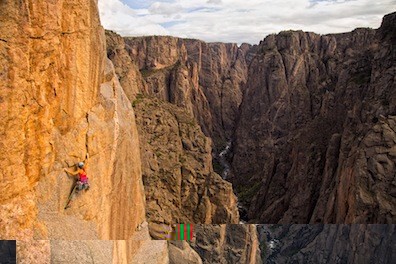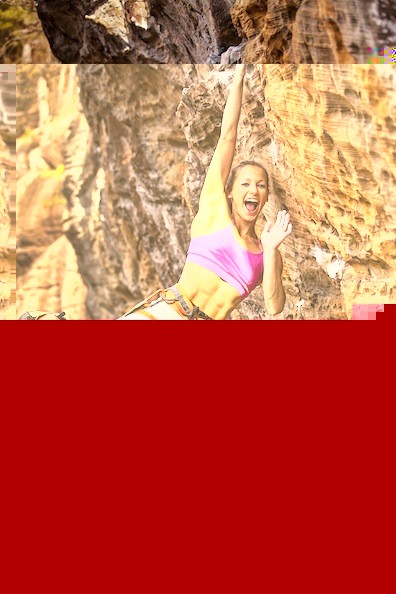In Women Who Dare: North America’s Most Inspiring Rock Climbers, renowned adventure photojournalist and Salt Lake City resident Chris Noble celebrates women’s athleticism in both word and photo. Noble, who’s been published in Life, National Geographic and Outside, among other magazines, captured stunning color photos of 20 of the sport’s leading female climbers and displays them next to full-length interviews. Featuring both legends like Lynn Hill and rising stars like Sasha DiGiulian, the book highlights these climbers’ dedication and passion for perfecting their craft. Women Who Dare was released Nov. 12 (Falcon, Paperback, $24.95).
How did Women Who Dare come about?
In 2010, I was hired to produce a calendar of women rock climbers for Falcon/Globe Pequot Press. Everyone loved the results, but wall calendar sales were already in decline, and it was expensive to pay me to travel around the country capturing these images. Simultaneously, I found I really loved working with the female climbers, but I also felt frustrated that the calendar could demonstrate so little of their amazing talent. I felt that these incredible athletes deserved so much more than to simply be “Miss July.”
The calendar left me wanting to know more—more about what drove these athletes, where they’d come from and where they were going. I wanted to know what they loved and what they hated about their chosen sport.
Did you find any patterns or themes that surprised you?
What surprised me most was the unbridled enthusiasm each woman had for her life and career. I’m a boomer, and I was raised in a time when dedicating your life to an activity like climbing would have been met with raised eyebrows and a question like, “Well, that’s nice, dear, but when are you going to settle down and make something of yourself?” I love the fact that the women profiled in Women Who Dare are unashamedly, unabashedly, unapologetically in love with climbing. That kind of passion and enthusiasm gives us all permission to become more fully ourselves, in whatever way our heart leads.
What is it about climbing in particular that makes these stories so powerful?
One of the few true instincts in humans is the fear of heights. Everyone’s born with that fear, while some certainly have more than others. Some fear is crucial when climbing, because it keeps you alert and aware, but, of course, too much fear can be debilitating, because it makes rational decisions and physical grace impossible. So, in my mind, climbing is an exceptional activity because mastery requires direct confrontation of one’s most basic fears and limitations.
Added to that, the women profiled in this book have completely dedicated themselves to the climbing lifestyle. And I believe people are always interested in those who dedicate themselves to excellence in any field of human endeavor, but especially when that endeavor is so obviously risky—and takes place in the most breathtaking landscapes imaginable.
Why not a book called Men Who Dare?
It wouldn’t have been nearly as interesting or unique, because there are countless books and articles about male climbers and their achievements. I don’t think it would have been so intimate or personal, either. Men have a much harder time expressing their inner feelings and limitations than women do.
Why is it important to celebrate women’s climbing specifically?
While women have obviously made incredible advances in every area of modern culture and society, in many cases, they are still not given the recognition, financial rewards and respect that male athletes receive. Climbing is no exception, despite the fact that over the past 20 years, women climbers have infiltrated every niche of the climbing world and quietly transformed the sport. I’m extremely proud to have been able to provide a forum for some of the world’s best women climbers to tell their own story. It’s truly a project whose time has come.
What’s the relationship between your images and their words?
With all my photography, I strive to transport the viewer into a scene or situation they may never otherwise experience. I try to delve beneath everyday appearances to discover the hidden essence of the subject. I can’t envision this book without the images we created for it. The photographs are a form of performing art, a collaboration between myself and the athlete, that speaks of our mutual love of climbing. But, of course, the text is equally important because it allows each climber to tell her own story, in her own words.
What’s the most important lesson that you think this book teaches?
The most important thing I learned from the book is to embrace your own inner climber. Which is really another way of saying follow your bliss—wherever it may lead. Stop feeling guilty about what makes you happy and pursue it with all your heart. The rest will fall into place. As Brittany Griffith says in her profile, once you align everything else in your life around the thing you love—in this case, climbing—all the other important aspects, like relationships, job, family and recreation, become properly aligned, as well.
What do you want people to consider after reading this book?
If there’s one thing I’d like readers to take away it would be the realization that none of the women profiled in Women Who Dare are superhuman. We tend to place the heroes we see in the media on a pedestal and think they’re somehow special, and that we could never reach as high. Malarkey! Our heroes are just other human beings who have had the courage, grit and determination to craft their lives around their passions. All of us have it in our power to move more in that direction. And I also believe this book offers girls and young women powerful, confident role models to emulate and mirror. Everyone needs those kinds of examples in this society.
Talk about the challenges of getting these shots.
The biggest challenge of this project was scheduling. Seriously, trying to schedule climbers is a lot like herding cats, except with cats, you can actually count on them to show up for a meal once in a while. Professional climbers live to climb, and everything else—including meals—is strictly secondary. So, I spent a huge amount of time pressing climbers to commit to dates and locations. It was also physically demanding. For example, Madaleine Sorkin and Kate Rutherford are both known for big-wall ascents, so we decided it would be really cool to photograph them in Colorado’s Black Canyon of the Gunnison, a breathtaking chasm about a mile wide and 1,500 feet deep. So, we borrowed a single 600-foot-long piece of static rope for the project, and we started rappelling from the top down. Trouble is, 600 feet of rope is pretty heavy, and it’s nearly impossible to keep sorted and knot-free when you’re hanging in space.
There’s also the Pucker Factor. The Pucker Factor is what climbers call the sensation when you walk to the edge of a high, vertiginous drop like the Black Canyon and contemplate going over the edge. One look down, and your butt puckers up so badly you can barely walk, and your brain starts shouting, in no uncertain terms, that dangling so far above the ground on such a slender thread is a very bad, in fact, insane idea. No matter how many times you’ve done this kind of thing, you always have similar emotions to wrestle with, which is a good thing, because fear—in proper measure—keeps you alive in situations like these.
So, Madeleine, Kate and I rappelled over the edge, fixing the 600 feet of rope at strategic points on the vertical wall as we went. When we ran out of static line, the women rappelled two more pitches on their own rope, then started climbing back up toward me. I photographed them as they climbed by ascending the fixed line, then pulling it up, and stuffing it into a large haul bag as I went.
It’s difficult to describe what a wild environment the Black Canyon really is. In places, you’re looking down the entire 1,500 feet of air to the Gunnison River, which is like a tiny white ribbon on the canyon floor. Along the edges of the route, there are huge stacks of loose rock so precariously balanced you could literally pull a ton of rock down on yourself just by brushing against the wrong piece. There is continual danger of rock fall coming down from above. In places, the wall was so overhanging I was simply dangling in space, not touching anything, and when that happens, you start to spin due to the twisting and untwisting of the rope. Another nagging concern is that the static line, as strong as it is, could be sawing on a sharp edge somewhere above.
But, of course, you have to lock these thoughts firmly in the back of your mind and concentrate on capturing the image that really nails the experience.
A SAMPLE OF CHRIS NOBLE'S SHOTS FROM THE BOOK:
More by Austen Diamond
-
Wasted Space
342 S. State, Salt Lake City
- May 6, 2015
-
Jackalope Lounge
372 S. State, Salt Lake City
- Apr 22, 2015
-
Geeks Who Drink at Piper Down Pub
1492 S. State, Salt Lake City
- Apr 15, 2015
- More »







